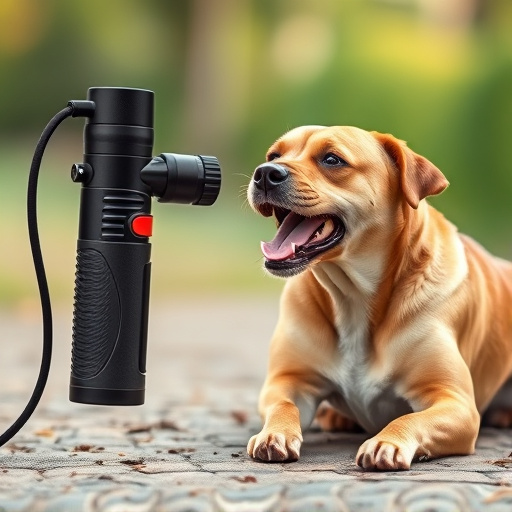Dog attack prevention pepper spray, or mace spray, is a non-lethal self-defense tool that temporarily blinds and disorientes aggressive dogs, providing escape time. For maximum effectiveness, users should:
1. Choose products designed specifically for canine deterrence with high capsaicin concentrations and versatile stream/mist modes.
2. Practice holding, targeting, and deploying techniques regularly in a controlled environment to minimize blowback.
3. Master techniques through balanced safety practices, understanding spray range, targeting sensitive areas, and regular training with certified instructors.
4. Simulate potential dog attack scenarios for improved response time and decision-making.
In the realm of personal safety, dog attack prevention pepper spray stands as a game-changer. This non-lethal self-defense tool has garnered attention for its potential to deter aggressive canines effectively. Understanding how this spray works and its role in canine deterrence is crucial for those seeking to protect themselves in areas with high dog populations. This article delves into the topic, offering insights on choosing the right pepper spray and mastering mace spray techniques—including safety guidelines and practical training tips—to ensure preparedness in case of a dog attack.
- Understanding Dog Attack Prevention Pepper Spray: Its Role and Effectiveness
- Choosing the Right Pepper Spray for Canine Deterrence: Key Features to Consider
- Mastering Mace Spray Techniques: Safety, Application, and Training Tips
Understanding Dog Attack Prevention Pepper Spray: Its Role and Effectiveness
Dog attack prevention pepper spray is a non-lethal self-defense tool designed to deter aggressive dogs and provide individuals with an additional layer of protection during potential encounters. This type of spray creates a temporary blindness and respiratory distress in the targeted animal, giving users precious time to escape or defend themselves. It’s crucial to understand that while pepper spray can be effective, it is not a universal solution and should be used as part of a comprehensive dog attack prevention strategy.
Learning how to properly use mace spray techniques is essential for anyone considering this method of protection. Practice makes perfect; individuals should familiarize themselves with the spray’s range, timing, and the recommended application methods. This includes understanding the distance at which to deploy the spray, how to aim it towards the dog’s face and eyes, and the importance of following up with a quick retreat. Regular training sessions can help ensure that in a real-life situation, users respond calmly and effectively, maximising the spray’s effectiveness as a deterrent.
Choosing the Right Pepper Spray for Canine Deterrence: Key Features to Consider
When considering dog attack prevention pepper spray, it’s crucial to choose a product designed specifically for canine deterrence. Not all pepper sprays are created equal; those intended for personal defense against humans may not have the right concentration or delivery system for effective animal deterrence. Look for sprays that contain a high percentage of capsaicin, the active ingredient responsible for the burning sensation and temporary incapacitation. The spray should also include a stream or mist mode to accommodate different scenarios, such as reaching a charging dog from a distance or settling for a cloud of pepper to disrupt its behavior.
In terms of features, consider products with a comfortable grip for easy handling during stressful situations. A durable construction that can withstand outdoor use and potential impact is essential. Additionally, some models offer UV protection to prevent the degradation of the spray, ensuring it maintains its potency over time. Familiarize yourself with local laws regarding the use of pepper spray, especially when dealing with animals, as regulations can vary significantly. How to Practice Mace Spray Techniques: Start by practicing proper holding and targeting techniques in a controlled environment. Learn the right distance to deploy the spray to maximize impact while minimizing blowback. Regular training sessions will ensure you’re prepared should you ever need to use this tool for self-defense or canine deterrence.
Mastering Mace Spray Techniques: Safety, Application, and Training Tips
Mastering Mace Spray techniques involves a blend of safety awareness, proper application, and adequate training. When practicing how to use pepper spray, always prioritize safety first. Never aim or discharge it at anyone unless absolutely necessary for self-defense, as accidental discharges can cause harm to bystanders. Familiarize yourself with the spray’s range and effects; understanding its limitations ensures you employ it effectively and responsibly.
Application requires a firm but controlled hand. Aim for the eyes, nose, and mouth—these are sensitive areas that pepper spray is designed to target. Practice deep breathing exercises before and after use to avoid inhalation of the spray yourself. Regular training sessions with a certified instructor are ideal, as they can provide hands-on experience and correct any missteps. Simulate various scenarios to sharpen your response time and decision-making during potential dog attack situations.
Dog attack prevention pepper spray is a powerful tool for personal safety when walking in areas with high canine populations. By understanding its role, choosing the right product, and mastering proper application techniques through practice, individuals can significantly reduce the risk of aggressive dog encounters. Integrating these strategies into your routine ensures you’re prepared to defend yourself should a confrontation arise, ultimately promoting peace of mind while navigating potentially risky environments. To effectively employ this deterrent, it’s crucial to commit to learning How to Practice Mace Spray Techniques for optimal safety and deterrence.
